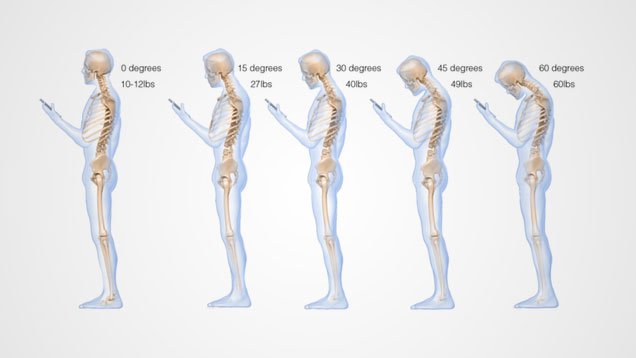Technology is constantly evolving at a faster and faster rate. Living in Silicon Valley, many of us are the first adopters of the latest and greatest technological advancements. These advancements are designed to make life easier but can often times have unintended negative consequences as well. One of the more recent advancements that seems to have created an uptick in pain and dysfunction over the last few years is the smart phone.
Since the release of the first iPhone in 2007, smart phone use has simply exploded. The average person spends between 700 and 1400 hours (29 to 58 days) per year simply looking down at her phone. Dr. Kenneth Hansraj, Chief of Spine Surgery at New York Spine Surgery and Rehabilitation Medicine recently created a model of the cervical spine to measure the amount of force that is exerted on the neck by the typical posture one uses when looking down at a smart phone. (link) It turns out, looking down at a smart phone can create between 27 and 60 pounds of force on the neck. Dr. Hansraj concludes that this position can result in a “loss of the natural curve of the cervical spine (which) leads to incrementally increased stresses about the cervical spine. These stresses may lead to early wear, tear, degeneration, and possibly surgeries.”
Shortly after Dr. Hansraj released the findings of his model, all the major news outlets seemed to carry a story about “text-neck” and the risk of permanent neck damage from using a smart phone. A very small minority has questioned Dr. Hansraj’s conclusions claiming that the body is adaptable and that posture does not correlate with pain. (link) But adaptability does not necessarily result in improved function. Our discs adopt by bulging and herniating. Is that good? Probably not.
The bottom line is that our bodies can handle the stress from looking down at a smart phone just fine for short periods of time, but prolonged use in a stationary head forward and down position can begin to cause pain and dysfunction. In addition to smart phone use, we also see the same type of pain and dysfunction associated with prolonged stationary laptop use, cycling and looking through a microscope.
What should you do?
The bottom line is that our bodies are made to move. Sitting, standing or lying in one position for an extended period of time will eventually start to cause pain and dysfunction. Smart phones are just one more thing in our modern world that keeps us in a fixed position. So be cognizant of your body, the positions you are in and the amount of time you are spending in those positions. It is unrealistic to think that people are simply going to stop using a smart phone. So here are some simple guidelines to follow when using a smartphone.
(1.) Never have your head tilted down to look at your phone for more than 5 minutes at a time.
(2.) When you take a break from tilting your head down, look up at the ceiling and then from side to side.
(3.) Make sure to stretch your neck periodically when using your smart phone for extended periods of time.

